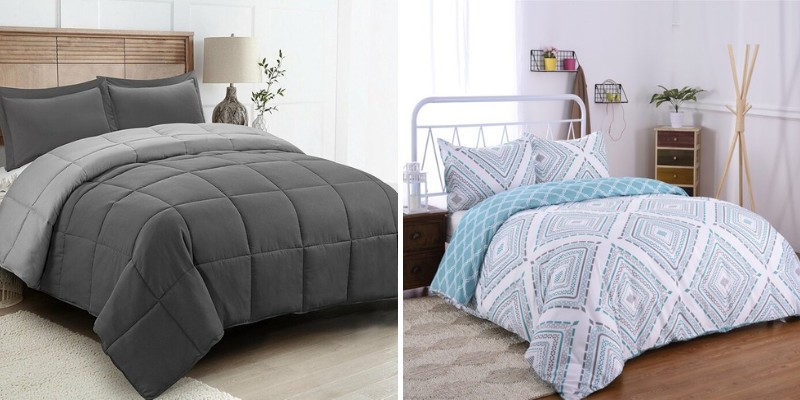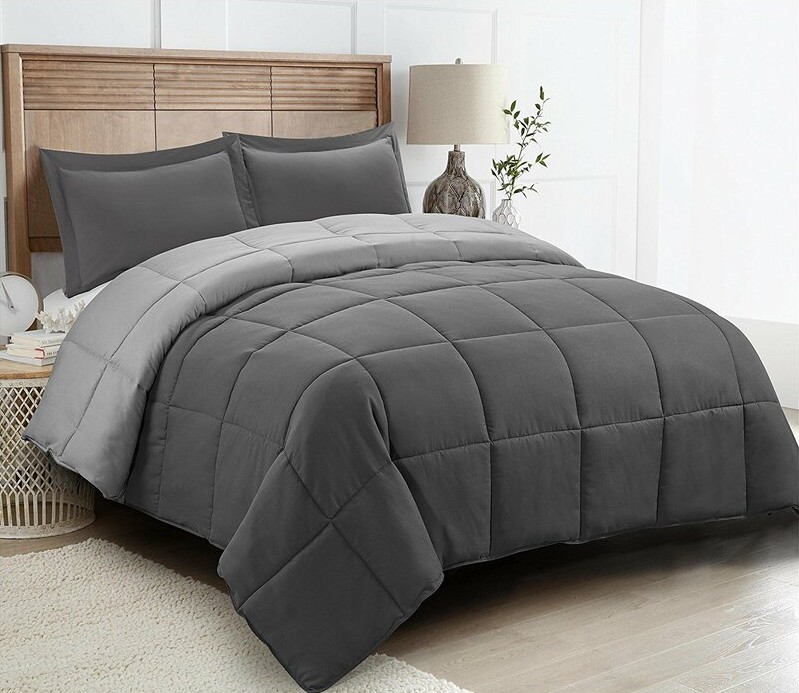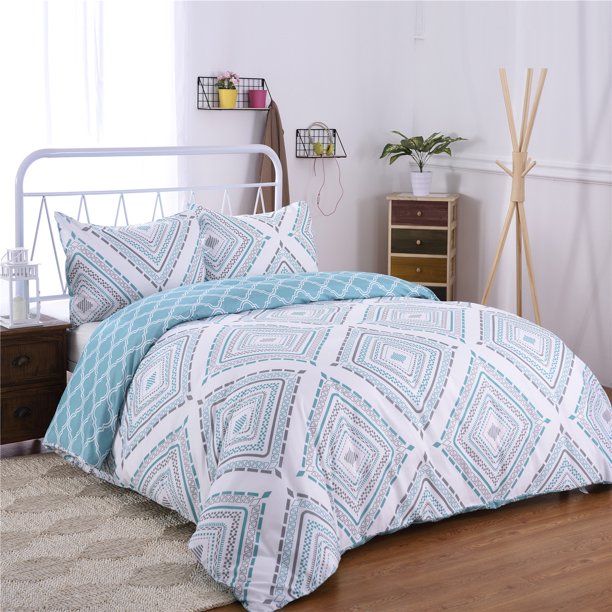Would you like to dress up your bed with a plush covering? Comforters and duvets are classy options. Both types of bedding issue a lovely invitation to restful sleep. Moreover, each will lavish you with relaxing warmth and a sense of security.

While comforters and duvets look similar, they’re constructed differently.
Thus, the way they’re sewn results in advantages and drawbacks.
In this post, you’ll learn all the nuances of each design. By this, you’ll know what’s best for your budget, decor, and sleeping needs.
Let’s compare and contrast Comforters vs Duvets as bedding options for your home.
What is a Comforter?
Originating in the US, a comforter is a one-piece, fluffed, insulated blanket. Filler materials can be feathers, down, or synthetic fibers.

Since the filler is evenly distributed, it has a uniform loft. Moreover, stitching anchors the insulation, keeping it smooth.
A comforter lacks a protective cover. Typically, its outer material consists of polyester, cotton, or a cotton/polyester blend. A comforter is also thick and large, overhanging the side of your bed.
Advantages of Comforters
- Decorative
Comforters are dressy, available in vast colors, textures, patterns, and prints. You’ll readily find a style that blends with your bedroom decor.
- Package Deals
Some manufacturers sell comforters with matching accessories, termed a “bed-in-a-bag.” So, along with a comforter, you may get coordinating sheets, pillowcases, and shams. Curtains may be included, too.
Thus, you save time hunting for additional linens. With one purchase, you can easily outfit your bed.
- Convenient Placement
Once you remove a comforter’s packaging, it’s ready to place on your mattress. Due to its one-piece construction, it’s a breeze to situate.
- Sleek Look
Comforters lay evenly. Their stitching is balanced, spreading the filler equally and securing it. Meanwhile, their outer materials create a smooth profile.
After making your bed, even with blankets beneath a comforter, it remains lump-free. Thus, if you like to layer your bedding while keeping it tidy, a comforter is ideal.
Drawbacks of Comforters
- Cleaning
Since comforter materials vary, their cleaning instructions do as well. Some comforters suit machine washing. However, if the piece is large and bulky, it may not fit inside a household washer.
In that case, you’ll need to pay visits to a laundromat. Still, you can save time and effort by entrusting a comforter to a drop-off laundry service.
To maintain a comforter, try to wash it once a month, spot-cleaning as needed. If a pet or small child likes to sleep with you, it may need more frequent washing.
If the care instructions say “Dry Clean Only,” you have no other option. Dry cleaning a comforter is expensive. According to a recent nationwide survey, the price ranges of dry cleaning are from $20 to $40. The exact cost depends on comforter material, size, and where you live.
Thankfully, you can reduce cleaning frequency and cost in two ways. One is by protecting your comforter with a duvet cover, described later in this post. Secondly, keep a top sheet under your comforter, preventing contact with your skin oils.
- Limited Lifespan
Over time, washing a comforter can reduce its loft. Plus, if it gets damaged, you’ll want to buy a replacement.
What is a Duvet?

A duvet is the European version of the American comforter. Pronounced “doo-vay,” its design hails from France. Essentially, a duvet is a fluffy, dense piece of filler, nestled inside a cover.
“Duvet” is French for down, the original filling material. Geese and ducks supply down, delicate fibers beneath their feathers, insulating the birds against cold.
Currently, duvet manufacturers use a range of fillers as insulation. Along with down and feathers, they can opt for wool, cotton, synthetic down, and silk.
A duvet isn’t meant to be seen. For this reason, most are off-white or white.
Regarding bed coverage, you have two choices. You can buy a duvet sized to the top of your mattress. Or choose a larger one, draping the side of your bed.
What is a Duvet Cover?
Like a gigantic pillowcase, a duvet cover encloses the piece of filler. It protects the insert from spills, dirt, tears, and body oils. Since the cover creates a skin barrier, you can skip using a top sheet, termed “sleeping European style.”
Usually, casings are either polyester, cotton, or a cotton/polyester blend. Also available are duvet covers made from linen, flannel, silk, and fake fur. Weaves and textures vary, but all are designed to be soft against your skin.
Advantages of Duvets?
- Restyling Flexibility
With the removable duvet cover, you can switch the look of your bedding easily. Casings are much cheaper than duvet inserts, giving you abundant choices.
If you omit a top sheet, you’ll expedite making your bed. Plus, while you sleep, a top sheet can migrate over the side or get tangled in your legs. These are two more perks of sleeping European-style.
- Coziness
Duvet inserts are somewhat heavy and super-fluffy. Their loft comes from high “fill power,” the volume and thickness of their insulating material. Thus, when sleeping under a duvet, you’ll feel secure and pampered.
- Cleaning
A duvet cover reduces the need for frequent maintenance. Still, never cleaning a duvet can result in a dust mite infestation. At a minimum, try to clean your duvet twice a year.
Do you have asthma or other breathing challenges? In that case, it helps to clean a duvet when the seasons change.
Refer to the instructions on the duvet care tag. Some inserts require special handling during washing to avoid damage. Otherwise, the filler can get misshapen. Frequently, duvets are “Dry Clean Only.”
Conversely, most duvet covers are machine-washable. Unless you have soiling mishaps, monthly washings should suffice.
- Longevity
A well-made duvet should last at least five years.
To prolong duvet integrity, choose one with sturdy filler, skillful construction, and a high-quality cover. The most durable covers have a minimum thread count of 300. Even with these features, a duvet may need occasional fluffing.
What are the Disadvantages of Duvets?
- Assembly
Tucking a duvet into its cover can be a chore. You accomplish this feat in stages. First, grasping two corners of the duvet, push them toward the top end of the cover. Then, repeat for the bottom end. Next, to even out the loft, shake and fluff the insert.
Some manufacturers facilitate duvet assembly. One way is by anchoring the filler material with a quilted pattern. Thus, the stitching keeps the filler balanced.
Secondly, some duvet covers attach to the insert corners, preventing shifting. Fasteners can be clasps, zippers, buttons, or ties.
- Filler Drift
Without sewn-in filler and fasteners, inserts will stray. Eventually, the duvet corners will bunch up inside its cover.
Usage Comparison – Duvet vs. Comforter
- Styling Variety
Just by changing a duvet cover, you can switch the ambiance of your bed. With a comforter, whenever you want a different look, you must buy new bedding.
- Warmth
Generally, comforters have less filler than duvets, making them thinner and lighter. For greater warmth during winter, you may need an extra blanket or two.
Since duvet inserts have more fill power, they’re toastier than comforters.
- Seasonal Adjustments
“Tog ratings” help you estimate duvet warmth. The scale ranges from 2.5 to 15, measuring heat-trapping capacity. You might even buy two duvets, suiting summer and winter weather.
For instance, some people use a 4.5 tog duvet during warmer months. Come winter, they switch to a 13.5 tog duvet.
- Individualization
What if you sleep with a partner whose metabolism differs markedly from yours? In that case, buy a split-tog duvet! This design tailors the volume of filler to each bed partner. Thus, while sleeping, you’ll both be comfy.
Comforters don’t make such accommodations.
Which is Cheaper, a Duvet or Comforter?
The long-term expense depends on five factors:
– a given manufacturer
– materials used and their durability
– cleaning costs
– the care you provide
Upfront Costs
Both types of bedding come in a range of prices suiting all budgets. Materials influence costs, the priciest being down. So, whether you choose a duvet or comforter, you’ll pay less with synthetic filler.
Since a duvet is a two-piece blanket, buying a separate cover can raise the expense. Still, some manufacturers include covers with their duvets, reducing the total cost.
On the other hand, buying a comforter as a “bed-in-a-bag” can be cheaper. At a discounted price, you also get pillowcases and sheets. Shams and curtains may be included, too.
Durability
Since a duvet cover guards the filler, permanent damage isn’t likely. If you follow the duvet care instructions, the insert should last five years or more.
Conversely, a comforter has no accident protection. Still, by enclosing it in a duvet cover, you can extend a comforter’s lifespan.
Maintenance Factor
When considering a purchase, note the care instructions. The cleaning required can jack up the long-term cost, especially for a “Dry Clean Only” item.
Comforter vs Duvet for Hot Sleepers
If you tend to overheat while sleeping, there are two bedding remedies.
- Buy a “cooling comforter.”
Its external fabric is breathable, releasing heat and letting cool air penetrate. Meanwhile, the material wicks away perspiration.
Additionally, cooling comforters regulate your body temperature with adaptable fillers. When the room temperature is warm, the filler absorbs your body heat. If it gets cool, the filler releases the stored warmth.
To find the best cooling comforter for you, visit product review websites.
- Get a “temperature regulating duvet.”
Shop for one with a tog rating of 2.5 to 4.5. Such a duvet is lightweight, having less insulation. Choose a natural filler, such as cotton or ethically sourced down. These materials let air circulate while wicking moisture from your body.
Also, outfit your bed with a cotton duvet cover, pillowcase, and sheets. Cotton allows your skin to breathe freely.
Some manufacturers sell “all-season duvets.” With one purchase, you get two blankets, each well-suited to summer and winter conditions.
Again, read product review websites to inform your choice.
Which is better overall, a Duvet or Comforter?
The answer depends on your preference for styling, warmth, cleaning, and replacing.
Consider a duvet if you seek:
– design flexibility
– cozy warmth, achieved with less bedding
– forgoing a top sheet
– simplified cleaning
– a plush blanket that won’t likely go flat
Opt for a comforter if you desire:
– a matching bedding ensemble
– not having to wrestle with duvet assembly
– uniform, effortless filler distribution
– layered bedding, accommodating blankets
– a smooth top profile
May you sleep comfortably and deeply!
Related Posts
- Comparison of Duvet vs Quilt vs Blanket: Cozy Bedding Explained
- Pros and Cons of Electric Blankets and Safety Guide
- Comparison of Murphy Bed vs Sleeper Sofa For Your Home
- Different Types of Doors for Closets – Design Ideas with Pictures
- Two Color Combination for Bedroom Walls – Design Ideas
- White and Gold Bedroom Design Ideas With Unique Photos
Leave a Reply